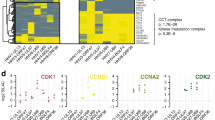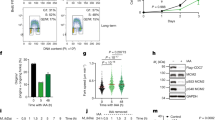Abstract
CYCLINS are regulatory subunits which associate with kinases to form complexes that control many of the important steps in cell-cycle progression. The best characterized of the cyclin-containing complexes is the association of cyclin B with the p34cdc2 kinase. The p34cdc2/cyclin B complex is required for the G2 to M transition (see refs 1–4 for review), but the physiological role of other cyclin complexes is unclear. Human cyclin A binds independently to two kinases, associating with either p34cdc2 or a related protein, p33 (refs 5–7). In adenovirus-transformed cells, the viral E1 A oncoprotein seems to associate with p33/cyclin A but not with P34cdc2/cyclin A (B. Faha, M.M., L-H.T. and E.H., manuscript submitted). To isolate the gene for p33, we have cloned several novel human cdc2-related genes. The protein product of one of these genes, cdk2 (cyclin-dependent kinase 2), shares 65% sequence identity with p34cdc2 (ref. 8) and 89% identity with the Xenopus Eg-1 gene product9. Immmunochemical characterization and partial proteolytic mapping show that the cdk2 gene product is the cyclin A-associated p33. Immunoprecipitations of the p33cdk2 protein suggest that it can act as a protein kinase in vitro. As p33cdk2 is bound to cyclin A and is targeted by the viral El A protein, we suggest that the p33cdk2/cyclin A complex has a unique role in cell-cycle regulation of vertebrate cells.
This is a preview of subscription content, access via your institution
Access options
Subscribe to this journal
Receive 51 print issues and online access
$199.00 per year
only $3.90 per issue
Buy this article
- Purchase on SpringerLink
- Instant access to full article PDF
Prices may be subject to local taxes which are calculated during checkout
Similar content being viewed by others
References
Murray, A. W. & Kirschner, M. W. Science 246, 614–621 (1989).
Nurse, P. Nature 344, 503–508 (1990).
Pines, J. & Hunter, T. New Biol. 2, 389–401 (1990).
Draetta, G. Trends biochem. Sci. 15, 378–383 (1990).
Giordano, A. et al. Cell 58, 981–990 (1989).
Pines, J. & Hunter, T. Nature 346, 760–763 (1990).
Giordano, A. et al. Science (in the press).
Lee, M. G. & Nurse, P. Nature 327, 31–35 (1987).
Paris, J. et al. Proc. natn. Acad. Sci. U.S.A. 88, 1039–1043 (1991).
Draetta, G. & Beach, D. Cell 54, 17–26 (1988).
Harlow, E., Whyte, P., Franza, B. R. Jr & Schley, C. Molec. cell. Biol. 6, 1579–1589 (1986).
Lehner, C. F. & O'Farrell, P. EMBO J. 9, 3573–3581 (1990).
Saiki, R. K. et al. Science 230, 1350–1354 (1985).
Hanks, S. K., Quinn, A. M. & Hunter, T. Science 241, 42–52 (1988).
Krek, W. & Nigg, E. A. EMBO J. 10, 305–316 (1991).
Gould, K. L. & Nurse, P. Nature 342, 39–45 (1989).
Arion, D., Meijer, L., Brizuela, L. & Beach, D. Cell 55, 371–378 (1988).
Langan, T. A. et al. Molec. cell. Biol. 9, 3860–3868 (1989).
Elledge, S. J. & Spottswood, M. R. EMBO J. 10 2653–2660 (1991).
Ninomiya-Tsuji, J., Nomoto, S., Yasuda, H., Reed, S. I. & Matsumoto, K. Proc. natn. Acad. Sci. U.S.A. (in the press).
Nurse, P. & Bissett, Y. Nature 292, 558–560 (1981).
Piggott, J., Rai, R. & Carter, B. Nature 298, 391–393 (1982).
Bellett, A. J. D. et al. Molec. cell. Biol. 5, 1933–1939 (1985).
Stabel, S., Argos, P. & Philipson, L. EMBO J. 4, 2329–2336 (1985).
Kaczmarek, L., Ferguson, B., Rosenberg, M. & Baserga, R. Virology 152, 1–10 (1986).
Graham, F. O., Smiley, J., Russell, W. & Nairn, R. J. gen. Virol. 36, 59–72 (1977).
Harlow, E., Crawford, L., Pim, D. & Williamson, N. J. Virol. 39, 861–869 (1981).
Harlow, E., Franza, B. R. Jr & Schley, C. J. Virol. 55, 533–546 (1985).
Whyte, P. et al. Nature 334, 124–129 (1988).
Sanger, F., Nicklen, S. & Coulson, A. R. Proc. natn. Acad. Sci. U.S.A. 74, 5463–5467 (1977).
Lane, D. P. & Robbins, A. K. Virology 87, 182–193 (1978).
Cleveland, D. W., Fischer, S. G., Kirschner, M. W. & Laemmli, U. K. J. biol. Chem. 252, 1102–1106 (1977).
Smith, D. B. & Johnson, K. S. Gene 67, 31–40 (1988).
Buchkovich, K., Duffy, L. A. & Harlow, E. Cell 58, 1097–1105 (1989).
Hermann, C. H., Su, L.-K., Whyte, P., Buchkovich, K. & Harlow, E. J. Virol. (in the press).
Author information
Authors and Affiliations
Rights and permissions
About this article
Cite this article
Tsai, LH., Harlow, E. & Meyerson, M. Isolation of the human cdk2 gene that encodes the cyclin A- and adenovirus E1A-associated p33 kinase. Nature 353, 174–177 (1991). https://doi.org/10.1038/353174a0
Received:
Accepted:
Issue Date:
DOI: https://doi.org/10.1038/353174a0



